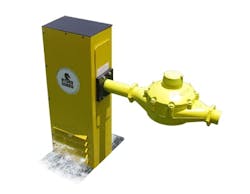Located just east of the central coastal region of South Louisiana, Assumption Parish is bordered by the Mississippi River’s industrial corridor to the north and the Gulf of Mexico’s oil and gas industry to the south. It is home to about 23,000 people, who rely on Assumption Parish Waterworks District No. 1 to provide a dependable supply of high-quality drinking water to the nearly 10,000 service connections and to neighbor utility Ascension Consolidated Utilities District No. 1. In November 2013, the State of Louisiana Department of Health & Hospitals issued an Emergency Rule requiring drinking water systems to raise the minimum disinfectant residual level to 0.5 mg/L and increase monitoring by 25%.
The Problem
Initially, Assumption Parish increased traditional flushing, which required crews to manually open hydrants near the ends of their water distribution system. In an effort to reduce cost and improve the productivity of its crews, the utility started installing the Hydro-Guard HG-6 hydrant-mounted automatic flushing system from Mueller Co. The HG-6 allowed the parish to take automatic and programmable flushing capabilities anywhere in the water distribution system where a fire hydrant is available. It is lightweight, portable and adjustable, so it can be connected to the hose nozzle of any brand of hydrant. To date, the parish has installed approximately ten of these devices.
However, the parish started having issues with people removing the HG-6s from the hydrants or turning off the hydrants being flushed by the units. If this was allowed to continue, it might have prevented the utility from maintaining the required disinfectant residual levels at critical points in the distribution network. Therefore, more visibility of these automatic flushing devices was needed.
The Solution
Mueller Co. then introduced Assumption Parish Waterworks District No. 1 General Manager B.J. Francis to technology that remotely monitors pressure continuously at any point within a potable water distribution system. This technology involves adding a sensor to transmit pressure readings. The pressure sensors, which are typically installed two per district metering area, report at user-defined intervals via cellular service and a Mueller-hosted secure web server and provide event warnings via text messages and e-mail when pressures exceed a utility’s defined warning levels.
Mueller’s remote pressure monitoring and Hydro-Guard automated flushing systems are part of the company’s Intelligent Water Technology (IWT) portfolio—a full line of innovative solutions, products and services that actively diagnose, monitor and control the delivery of safe, clean drinking water to consumers and businesses. IWT delivers information that enables water systems to make smart decisions concerning their existing water infrastructure and plan for the future. Data-driven decisions help water systems reduce non-revenue water and optimize infrastructure investments, from main to meter.
The Conclusion
Initially, Assumption Parish installed a pressure sensor on a HG-6 attached to a hydrant located on the property of a resident who had been complaining of low water pressure. By documenting steady water pressure on the hydrant for a couple of weeks, the utility was able prove that low water pressure was in the resident’s system and not the utility’s.
Assumption Parish then moved the pressure sensor to a second location to monitor pressure on and operation of the Hydro-Guard HG-6 flushing system. Drops in pressure were visible at approximately 1:00 a.m. each day, which is when the HG-6 was programmed to flush. The utility is currently flushing this location for six hours daily in order to maintain the state-mandated disinfectant residual levels.
“The application of pressure monitoring has given the utility ‘eyes’ on the remote automated flushing system,” Francis said. “We also see where remote pressure monitoring can help determine where leaks may be occurring. Since many of our distribution lines go through swampy areas, leaks are not only invisible to us, but they are very tough to repair.”



